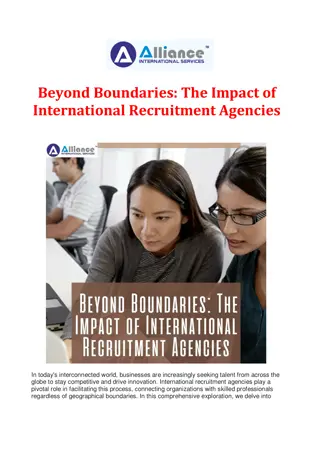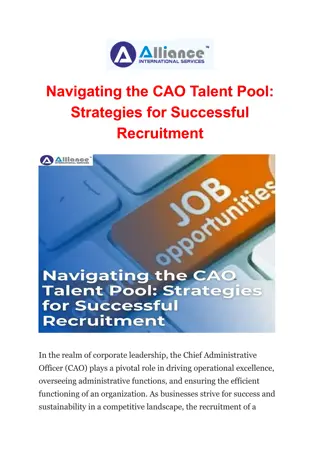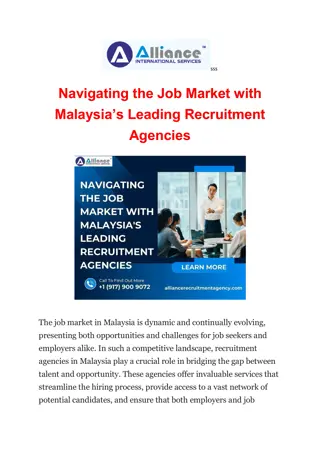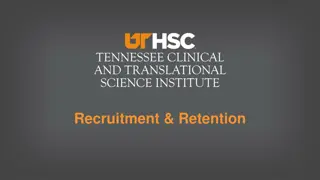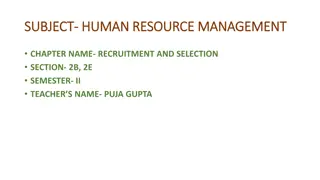
Internal vs External Recruitment: Pros and Cons in Hiring Practices
Discover the two sources of recruitment - internal and external - and their respective advantages and disadvantages. Internal recruitment can boost employee morale and loyalty but may limit innovation, while external recruitment brings fresh perspectives but requires more time and resources to onboard new talent.
Download Presentation

Please find below an Image/Link to download the presentation.
The content on the website is provided AS IS for your information and personal use only. It may not be sold, licensed, or shared on other websites without obtaining consent from the author. If you encounter any issues during the download, it is possible that the publisher has removed the file from their server.
You are allowed to download the files provided on this website for personal or commercial use, subject to the condition that they are used lawfully. All files are the property of their respective owners.
The content on the website is provided AS IS for your information and personal use only. It may not be sold, licensed, or shared on other websites without obtaining consent from the author.
E N D
Presentation Transcript
Recruitment It refers to the process of appointing possible candidates for a job or a function. It has been defined as the process of searching for prospective employees and stimulating them to apply for jobs in an organisation. Sources of Recruitment: There are two sources of recruitment Internal External
Internal Recruitment It is a recruitment which takes place within the concern or organization. Internal sources of recruitment are readily available to an organization. Internal sources of recruitment include: Transfers: means a change in place of employment without any change in the position, status, salary and responsibility of the employee. Thus, the situation can be filled by transferring an appropriate candidate from the same organization. Internal Advertisements: Now, the vacancy is promoted within the organization. The current employees are requested to apply for the vacancy. Therefore, recruitment is done from within the organization.
Internal Recruitment Promotions: means to give a higher position, status, salary and responsibility to employee. Therefore, the post can be filled by promoting an appropriate candidate from the same organization. Recall from Long Leave: The organization might recall a manager who has gone on a long leave. This is done when the company faces a problem which can only be solved by that specific manager. After he resolves the problem, his leave is extended. Retired Managers: Sometimes, retired supervisors may be reminded for a short period. This is done when the company cannot find an appropriate candidate.
Merits of Internal Sources It rises the morale or confidence of the employees and it improves the relationships in the organization. It decreases executive turnover. It develops loyalty, faithfulness and a sense of responsibility. It is time saving, cost-effective, simple and reliable. There is no need of orientation because the candidate already knows everything about the company, the work, the employee, the rules and regulations, etc. It motivates and encourages the employees to work hard in order to get advanced jobs in the same company.
Demerits of Internal Sources It avoids new blood from entering the company. New blood takes innovative ideas, fresh thinking and dynamism into the organization. It has limited scope because it s not possible to fill up all types of vacancies from within the organization. Those who aren t promoted will be unhappy. The right person may be transferred or promoted only if proper confidential reports of all employees are maintained. This includes a lot of time, energy and money. The position of the person who is transferred or promoted will be vacant. There may be partiality or bias in transferring or promoting persons from within the organization.
External Sources of Recruitment External sources of recruitment have to be solicited from outside the organization. External sources of recruitment are: Management Consultants: are used for choosing higher- level staff. They act as representative of the employer. They make all the essential arrangements for recruitment and selection. In return for services, they take a commission or service charge. Public Advertisements: The Personnel branch of an organization advertises the vacancy in the internet, newspapers, etc. This advertisement gives info about the company, the job and the required qualities of the candidate. It offers applications from suitable candidates. This source is the most common and popular source of recruitment. This is because it provides a very wide choice. However, it is very expensive and time consuming.
External Sources of Recruitment Recommendations: The company or organization may also recruit candidates based on the recommendations received from present managers or from sister companies. Deputation Personnel: The company may also recruit candidates who sent on deputation by the Financial institutions or Government or by holding or subsidiary companies. Campus Recruitment: The organization conducts interviews in the campuses of Engineering Colleges and Management institutes. Final year students, who're soon to get graduate, are interviewed. Suitable candidates are selected by the association based on their communication skills, academic record, intelligence, etc. This source is used for recruiting qualified, trained but inexperienced candidates.
Advantages of External Sources It boosts young blood with creative ideas to enter the organization. It offers wide scope for selection. This is because a huge number of suitable candidates will come for the selection procedure. Here there is no need to maintain confidential records. There are fewer chances of partiality or bias.
Limitations of External Sources It is very expensive. This is because test, advertisements, medical examination etc., has to be conducted. It is very time consuming because the selection process is very long. It may not develop loyalty amongst existing managers. The existing managers may leave the company if outsiders are given higher position.
Selection It can be defined as discovering most promising and most suitable candidate to fill up the vacant job position in the organisation. Process of selection and shortlisting of the right candidates with the necessary qualifications and skill set to fill the vacancies in an organisation. The selection process varies from industry to industry, company to company and even amongst departments of the same company.
Process of Selection Preliminary Interview: This is a very general and basic interview conducted so as to eliminate the candidates who are completely unfit to work in the organisation. This leaves the organisation with a pool of potentially fit employees to fill their vacancies. Receiving Applications: Potential employees apply for a job by sending applications to the organisation. The application gives the interviewers information about the candidates like their bio-data, work experience, hobbies and interests.
Process of Selection Screening Applications: Once the applications are received, they are screened by a special screening committee who choose candidates from the applications to call for an interview. Applicants may be selected on special criteria like qualifications, work experience etc. Employment Tests: Before an organisation decides a suitable job for any individual, they have to gauge their talents and skills. This is done through various employment tests like intelligence tests, aptitude tests, proficiency tests, personality tests etc.
Process of Selection Employment Interview: The next step in the selection process is the employee interview. Employment interviews are done to identify a candidate s skill set and ability to work in an organisation in detail. Purpose of an employment interview is to find out the suitability of the candidate and to give him an idea about the work profile and what is expected of the potential employee. An employment interview is critical for the selection of the right people for the right jobs. Checking References: The person who gives the reference of a potential employee is also a very important source of information. The referee can provide info about the person s capabilities, experience in the previous companies and leadership and managerial skills. The information provided by the referee is meant to kept confidential with the HR department.
Process of Selection Medical Examination: The medical exam is also a very important step in the selection process. Medical exams help the employers know if any of the potential candidates are physically and mentally fit to perform their duties in their jobs. A good system of medical checkups ensures that the employee standards of health are higher and there are fewer cases of absenteeism, accidents and employee turnover. Final Selection and Appointment Letter: This is the final step in the selection process. After the candidate has successfully passed all written tests, interviews and medical examination, the employee is sent or emailed an appointment letter, confirming his selection to the job. The appointment letter contains all the details of the job like working hours, salary, leave allowance etc. Often, employees are hired on a conditional basis where they are hired permanently after the employees are satisfied with their performance.
Importance of the Selection Process Proper selection and placement of employees lead to growth and development of the company. The company can similarly, only be as good as the capabilities of its employees. The hiring of talented and skilled employees results in the swift achievement of company goals. Industrial accidents will drastically reduce in numbers when the right technical staff is employed for the right jobs. When people get jobs they are good at, it creates a sense of satisfaction with them and thus their work efficiency and quality improves. People who are satisfied with their jobs often tend to have high morale and motivation to perform better.
Training and Development Training raining means equipping the employees with the required skill to perform the job. Development It refers to overall growth of the employee. It focuses on personal growth and successful employees development.
Benefits of Training for Organisations Reduced learning time Better performance Attitude formation Aids in or help in solving operational problems Managing manpower need Helps to adopt changes
Benefits of Training for Employees Better career options Earning more Boost up the morale Less chance of accidents
Difference Training Development It is process of increasing knowledge and skills. It is a processof learning and growth It is to enable the employee to do the job better It is to enable the overall growth of the employees. It is a job oriented process It is a career oriented process
Training Methods (i) On the Job Methods (a) Apprenticeship programmes (b) Coaching (c) Internship training (d) Job rotation (ii) Off the Job Methods (a) Classroom lectures (b) Films (c) Case study (d) Computer modelling (e) Vestibule training (f) Programmed instruction




